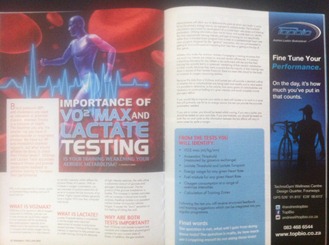Importance of VO2max and Lactate Testing
Posted on February 6th, 2012 by Andries
By Andries Lodder for TriathleteSA Magazine Dec|Jan 2012 Issue

Is your training weakening your aerobic metabolism?
Blood pressure (BP) and cholesterol are used as predictors of potential disease, whereas fitness is a predictor of health. The healthier you are, the less chances you have of cardiovascular or respiratory diseases. We get our BP and cholesterol checked regularly, what should athletes be doing to check their fitness levels? VO2max and Lactate Tests accurately measure fitness and provide constructive feedback to athletes looking to increase their performance.
Why is this important for a runner, cyclist or triathlete?
Keep reading and you’ll soon find out.
What is VO2max?
VO2max is the maximum rate of oxygen consumed in millilitres one can use in one minute per kg of body weight. It is an important test for evaluating the cardiovascular capacity of an athlete and is the maximum capacity to transport and utilize oxygen during incremental exercise. It is also known as aerobic capacity, which reflects the physical fitness of a person. With an increase in oxygen consumption, you see cascades of positive events that all serve to increase the fuel economy of an athlete. Highly trained athletes generally have a higher VO2 max than untrained individuals.

What is Lactate?
Lactate Threshold testing is considered to be the single most important determinant of success in endurance related activities. Training at the right intensity is important to help prevent over or under training. During the demands of high intensity exercise, the cells utilise a substantial amount of glucose and glycogen (stored glucose). The by-product of the glucose breakdown is lactate. This increase in lactate coincides with an increase in blood and muscle acidosis, therefore lactate is an excellent indirect marker of muscular cellular fatigue or the “burn” sensation or that feeling of hitting the wall.
Why are both tests important?
Both VO2max and lactate turnpoint are valuable and independent physiological markers for your current state of fitness, in addition the gas analysis measurements will allow you to determine the point at which your body is using fat as the primary energy source as opposed to carbohydrates. The threshold calculations are crucial for development of accurate heart rate zones and training parameters. Utilising information from the VO2max and lactate tests can identify the most appropriate training intensity and type of training for you specifically rather than a handed down program from a mate or a predetermined heart rate zone program designed for the “general” population who are just interested in getting fit, but not focused on improving their best time or getting to the top of their game.
Athletes who make the common mistake of engaging in training structures that are much too intense are subject to reduced aerobic efficiencies. It is always a shocking discovery for any athlete to be confronted with the fact that their training has actually led to a systematic weakening of their aerobic metabolism. In other words, because they were unaware that the majority of their training was done in excess of their lactate threshold, there has been little stimuli for the body to increase its oxygen consuming abilities.
Because the data from a Vo2max and Lactate test will provide a detailed outline of whether fat or carbohydrates are being used most readily and to what extent, it is possible to determine, to the calorie, how many grams of carbohydrates are necessary to continue fuelling at a given intensity and avoid complete muscle glycogen deficit.
If you would like to improve your ability to deal with lactate or to work in a zone that will primarily use fat as an energy source, this test can provide the accurate parameters needed.
If you are a runner, you should be tested whilst running, if you are a cyclist, you should be tested on your own bike. If you are triathlete, you should be tested on both the run and cycle as the information between the two efforts will vary in some cases by quite a margin.
From the tests you will identify:
VO2 max (ml/kg/min)
- Anaerobic threshold (measured by gaseous exchange)
- Lactate threshold and lactate turnpoint
- Energy usage for any given heart rate
- Fuel mixture for any given heart rate
- Oxygen consumption at a range of exercise intensities
- Calculation of INDIVIDUALIZED training zones
- Following the test you will receive structured feedback and training suggestions which can be integrated into you regular programme.
Final words
The question is not what will I gain from doing these tests? The question is really by how much am I crippling myself by not doing these tests!
Tweet